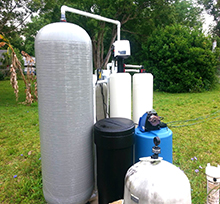“I’ve Got City Water” (In most all of Florida this is also well water)
Water is treated in the city, but approximately 2% is for in-home use. No doubt this water meets or exceeds EPA standards. The other 98% is for fire fighting, industrial use, etc. Now let’s say that the city treats this household water to an extremely high degree. It would still need to travel through miles of pipe that was installed who-knows how long ago?
ago?
It’s easy to see how more water treatment is necessary when water enters your home. The city could do it, but your bills would go through the roof.
Curious about what’s in your drinking water? Follow this link:
EWG’s Drinking Water Quality Analysis and Tap Water Database
City or Municipal Water
Water supply systems get water from a variety of locations, including groundwater (aquifers) and surface water (lakes and rivers). The water is then, in most cases, purified. The process goes something like this in the case of city/municipal water being fed by a groundwater supply:
Water first enters the water treatment facility through an inlet pipe with a large metal grill to keep out large debris.
A preliminary screening takes place at a pumping station, which removes fish, garbage, sewage, and grass.
Once the debris is removed, the raw water enters the water treatment plant. At this point the water is dirty, smelly and unsafe to drink. Activated carbon is added to the water to remove the bad taste and odor.
The water now enters a series of mixing tanks to coagulate and form clumps of sedimentation to be filtered mechanically removing all particulate matter. However, the clear water is still teaming with bacteria and viruses.
Technicians chlorinate the water by adding 1.9 ml per liter of water and, in many municipal water treatment systems; fluoride is also added to the water supply. Treated water then either flows by gravity or is pumped to reservoirs, which can be elevated in such cases as water towers or on the ground. Once water is used, wastewater is typically discharged in a sewer system and treated in a wastewater treatment plant before being discharged into a river.
We can conduct a drinking water test to determine the amount of chlorine in your water.
Well Water
“We Get Our Water From a Well”

Our drinking water is being destroyed. Did you know…
Every year at least 255 million metric tons of hazardous chemical wastes are dumped into our nation’s environment?
There are 400,000 landfills, ponds, pits and lagoons in the U.S. containing some of the most dangerous substances known?
There are 35,000 pesticides that are made from 600 chemical compounds – all potentially winding up in our water supply?
It is important to note that everyone’s water supply can be different. Contact us for a complete analysis of your water supply. Allow us to customize your water treatment system to meet your specific needs.
JC Galloway & Son – The Water Doctor is your premier water purification and water softener service in
Apopka, Altamonte Springs, Astatula, Bay Lake, Belle Isle, Beverly Beach, Bostwick, Bunnell, Casselberry, Clermont, Crescent City, Daytona Beach, Daytona Beach shores, Daytona North, DeBary,
DeLand, Deltona, Eatonville, East Palatka, Edgar, Edgewater, Edgewood, Eustis, Flagler Beach, Fruitland Park, Florahome, Georgetown, Grandin, Groveland, Heathrow, Holliste, Holly Hill, Howey In The Hills, Interlachen, Lady Lake, Lake Buena Vista, Lake Como, Lake Mary, Leesburg, Longwood, Maitland, Marineland, Melrose, Mondikes, Oakland, Ocoee, Orange City, Orlando, Ormond Beach, Osteen, Ovido, Palatka, Palm Coast, Pierson, Pomona Park, Putman County, Putman Hall, Sanford, San Mateo, Satuma, Seminole County, Tavares, Umatilla, Welaka, Winter Springs, and the rest of Volusia County in Florida. We also serve neighboring Flagler County, Brevard County, Orange County, Seminole County, and Lake County including the areas of Paisley & Sanford. If you are in the area surrounding Deltona & DeLand, Fl, we have you covered!
